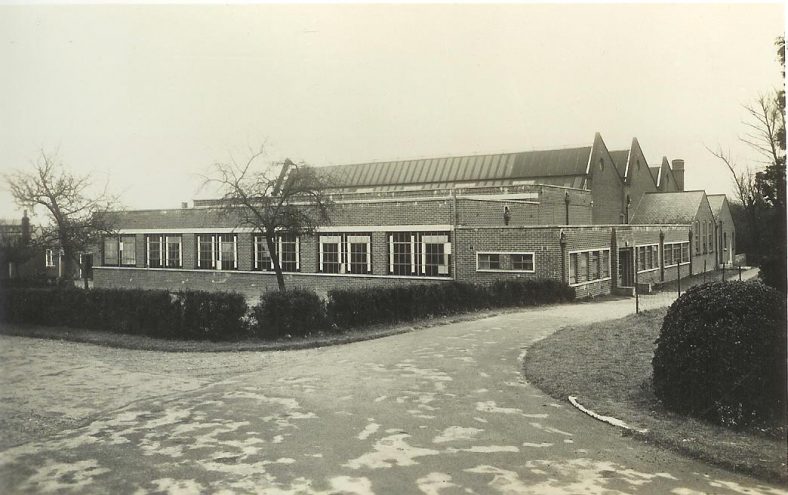
The printing school, 1945. Credit: Alan Hamblin
From its founding in 1871, the National Children’s Home & Orphanage* attached great importance to vocational training. When the Harpenden branch of the NCH was opened in 1913, the printing technical school attached to the previous headquarters building, in Bonner Street, Bethnal Green in London’s East End, was relocated to Highfield Oval in Ambrose Lane.

Former NCH Printing works, refurbished by YWAM. Credit: Alan Bunting, March 2015
The printing school building remains there today; after extensive refurbishment which was necessary to make it weatherproof, it is used as a lecture and assembly hall by YWAM (Youth With A Mission), the present occupants of the Highfield Oval site. During the 1950s, when Alan Hamblin was an apprentice at the printing school, the front of the building housed the offices of the manager – at that time Mr Basil Beck, who lived in Sauncey Avenue (and whose son Michael provided supplementary information for this article). There were also two secretaries, one of whom was Marjorie Coburn (sister-in-law of History Society founder member Amy Coburn. She married Alfred Bigg). Next to the offices was a classroom with 12 desks, where apprentices attended lectures preparing them for their City & Guilds printing trade examinations.
Behind were the main parts of the school, whose function combined the training of boys and girls from the branch in the various skills of the printing trade, with the production of most of the NCH’s books, publications and other printed matter. Printing for the Harpenden Trust charity, including its annual Christmas Appeal envelopes, was also undertaken.
Under a typical glass ‘north light’ factory roof, four similar-sized bays comprised the machine room, the composing room, the bindery and a capacious store room.
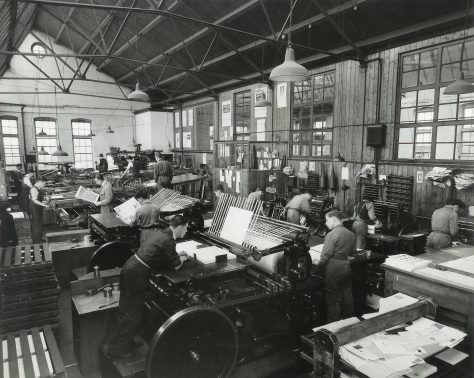
Machine room – 1951
In the machine room, around 20 boys worked, under the supervision of overseers Walter Milligan, Jessie Haylor (both of whom had served apprenticeships at Bonner Road) and Frank Bickerdyke.

NCH printing works. Miehle machines 1945. Credit: Alan Hamblin
The room was equipped with seven large printing machines: two old Wharfedales, three Miehles and, in the early 1950s, a newly-acquired Heidelberg.
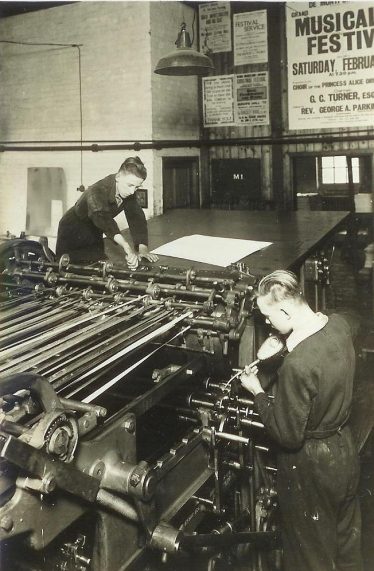
NCH printing works. Miehle machine 1945. Credit: Alan Hamblin
There were also seven smaller platen machines under the charge of another former Bonner Road boy, Eric French.
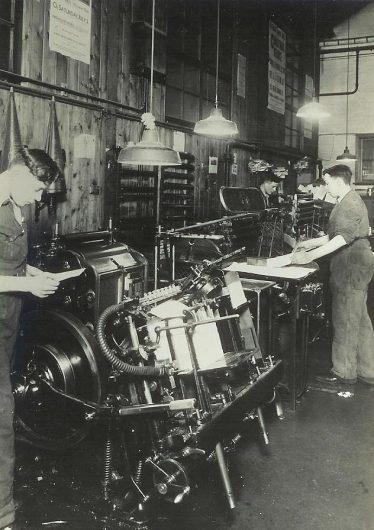
NCH printing works, platen machine 1945. Credit: Alan Hamblin
Composing – typesetting
In the composing or typesetting room, where another 20 boys were employed, under the supervision of Messrs Rycroft, Shotter and Glover, were a range of monotype keyboards and many frames of typematter, much of it kept for reprint use. An elderly Mr Pluck, who had also worked at Bonner Road prior to 1913, was employed as proof-reader. An annexe off the composing room housed the monotype caster – a ‘mini foundry’ of the kind which characterised all printing works in the days of hot metal print technology.
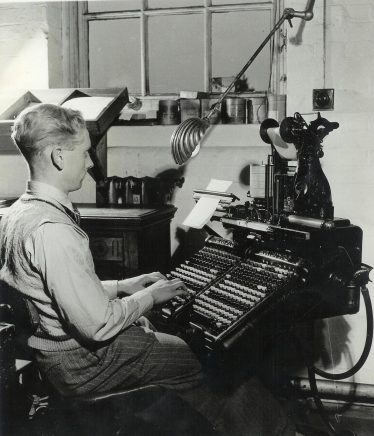
Monotype machine, 1951. Credit: Alan Hamblin
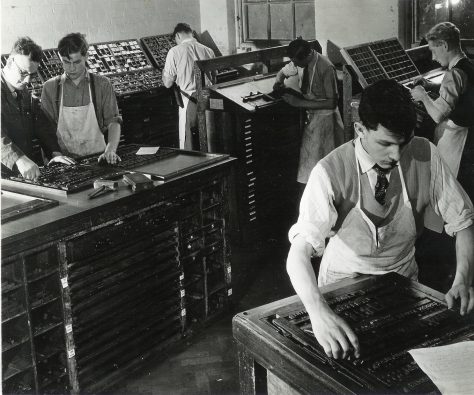
Composing room – Alan Hamblin is 2nd on the left
The bindery
Another old-stager from Bonner Road days was ‘Golly’ Allgood, overseer of the one or two boys in the bindery and folding department, where the tradition of hand bookbinding was maintained. But most of the bindery trainees were girls, supervised by Ethel Howard, who had joined the Highfield Oval printing school back in 1919.
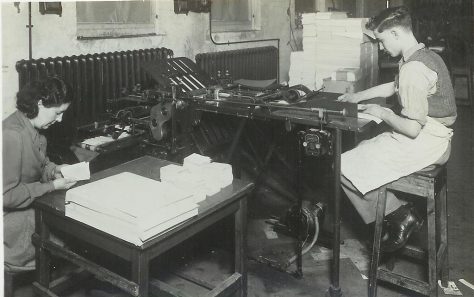
NCH printing works, bindery, 1945. Credit: Alan Hamblin
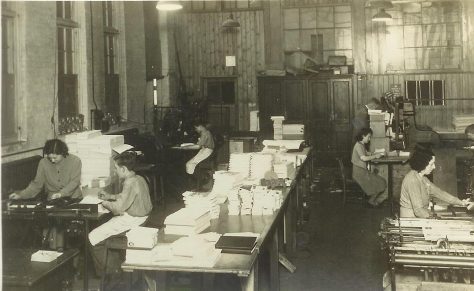
NCH printing works. Boys and girls in the Bindery 1945. Credit: Alan Hamblin
The two large guillotines in the bindery were worked by Stan Summerfield and Wilf Abbiss.
Work began at 8.00am, which was perhaps not too onerous for trainees, especially younger ones whose living quarters were in Ashcroft House, on the same NCH site, under the care of a Mr and Mrs Turner. Older apprentices were provided with hostel accommodation nearby in Harpenden. They nevertheless were all required to clock in; the clocking-in machine was at the entrance to the composing room. Wages were deducted for every 15 minutes late.
The printer’s hymn
Machine room overseer Walter Milligan wrote the words of the so-called printer’s hymn, entitled ‘The Knights of the Press’ which was sung at the annual NCH printers’ annual social, held each February.
The words ran as follows:
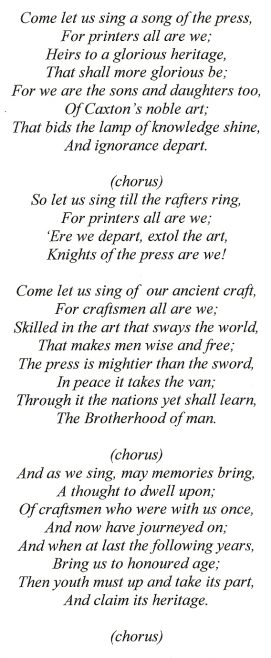
At the same event a game of indoor hockey was traditionally played in the branch’s Bernard Barren Hall, between composing room and machine room apprentices.
*Please note that he words ‘and Orphanage’ were officially removed from the name ‘National Children’s Home and Orphanage’ because many of the children in the Homes were not orphans and some remained in touch with their parent/s.
The name of the organisation is now
Action for Children https://www.actionforchildren.org.uk



Comments about this page
My mum, Mrs Doris Shaw worked at the PTS appx 1962, when I was 14. I knew many of the people who worked there, and have fond memories of NCH. I helped with the cub scouts at Elmfield, and much of my experience at The Oval shaped my life and career. Would love to hear from anyone
I’m Nick Butterworth. I was an apprentice at the NCH Printing School for 3 years from 1962 until the summer of 1965. I wasn’t from the Home, myself, but through friends of my family, I was offered an opportunity to work as a typographic designer at the Printing School. I also gained experience as a compositor and learnt a great deal about the process of printing as it was at that time. I left Harpenden to work as a graphic designer in London in 1965 and, after some changes of employment, launched into a freelance design career in 1968. I was 22 at the time. When my children came along, 10 years later, I switched emphasis to concentrate on illustration and subsequently, writing for children’s books. I’m still doing this, more than 40 years later!
I have strong and good memories of my time in Harpenden. I can remember quite a few names of boys who were there at the same time as me. Here are some that just might ring a bell somewhere: Bill Read; Mick Fulstow; Martin Hatton; Tony White; Roger Grout; Dick Dodds; Paddy Lacey; Jock Sneddon; John Newell; Alan Clark; Alan Tisbury; Rodney Hartshorn……and yes, I do remember you, Lenny Smith!
Just came across this page researching my family history/background, prompted by reading about British Soldiers of African Descent in the First World War (“Black Tommies” by Ray Costello) and came across Second Lieutenant Walter Tull, who was in care in NCH Bethnal Green (1897-1903?) and did his apprenticeship at the printing school in Bethnal Green before it moved to Harpenden. I too, was brought up in the care of the NCH (Frodsham), moving to Harpenden in 1963. I was looking for information about the Printing School and was delighted to find this comprehensive article. Mainly before my time, 1963-1967, but relevant.
I worked in the composing room from 1962 to 1968 – the last 2 years on a monotype caster. Natsopa stopped me working in London so I became a carpenter, thank god. Unions killed the printing industry. Anybody remember me?
Add a comment about this page